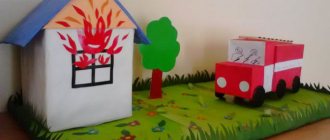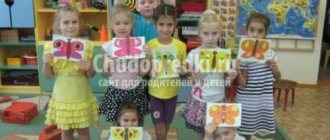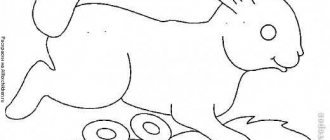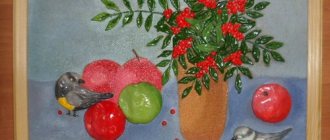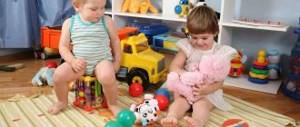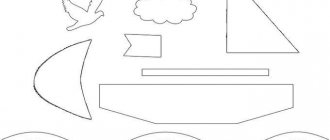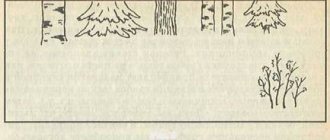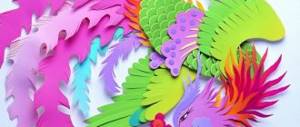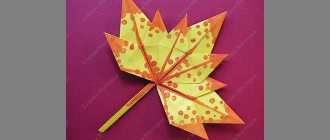Features of preparing and conducting a lesson on the “Round Dance” application
When planning a lesson on application in the preparatory group of a preschool educational institution, the teacher is guided by the requirements of the program, and they are quite high for children of this age.
Program requirements for children's skills and abilities
According to the exemplary educational program “Origins”, developed in accordance with the Federal State Educational Standard, children of the seventh year of life:
- create works of artistic value and applied significance (collages, panels, friezes, posters, wall newspapers, illustrations, postcards, invitation cards, bookmarks), acting individually or in collaboration with other people (children and adults);
- continue to master new methods of curvilinear cutting: symmetrical, pair-symmetrical, ribbon, silhouette (along a drawn or imaginary contour), applied applique for obtaining multi-color images, slotted decor for making openwork products (snowflake, flowerpot, napkin, curtain, clothes for dolls, masks and scenery for theatrical productions);
- freely combine mastered methods, combine appliqué techniques with various techniques of decorative drawing, artistic design, and children's design.
Theme options
With proper preparation and organization, an application on the theme “Round Dance” allows the teacher to carry out a significant number of the listed tasks.
A round dance can not only be danced, but also made in the form of an applique
Planning, as we know, begins with choosing a topic. “A festive round dance” in the minds of many adults is associated with the New Year, but those who work with children know that such applications can be timed to coincide with any occasion, given that a round dance is a mass ritual dance that accompanied any holiday among the ancient Slavs .
A round dance is a kind of symbol of beauty - the beauty of movement, the beauty of the surrounding world and, finally, human beauty. The main structure of the round dance is a circle, its circular composition (similar to the sun) and movement in the direction of the sun (walking after the sun - “posolon”) originate from ancient pagan rituals and games of the Slavs, who worshiped the powerful sun god.
Alexander Morgan
Article “Slavic culture. Round dance"
The subject of the application can be different, in particular:
- “Round Dance of Friendship” dedicated to National Unity Day;
- "Spring", marking the beginning of spring;
- “Autumn” - in honor of the harvest festival;
- “Rainbow”, which is appropriate when studying the colors of folk costumes;
- “New Year” on the eve of the winter holidays;
- "Birthday";
- fantasy (dolls, forest animals, snowmen, fish, Christmas trees, that is, characters who can only participate in an imaginary round dance).
Photo gallery: options for the “Round Dance” application (festive, friendship, Russian beauties, etc.)
The “Round Dance of Friendship” collage will introduce children to the culture of other countries
The application “Round Dance of Russian Beauties” will introduce children to the national costume
Round dance of Christmas trees made using ribbon technique
You can also use collage pictures to create a round dance.
The smaller the figurine size, the more difficult it is to “dress” and “undress” this figurine.
A round dance does not always mean little men, it can be rays of sunshine
A round dance of bunnies around the Christmas tree can be done using cotton pads
Application "New Year's round dance" with elements of quilling and mosaic - an excellent option for a postcard
The application “Round Dance of Snowmen” with elements of paper plastic develops spatial thinking
Collective or individual form of work: when to use
Work with the application can be both individual and collective. The teacher chooses the form depending on:
- the level of preparedness of children (if there are children who are too slow or unable to keep up with their studies, then it is more convenient to do group work so that everyone can express themselves to the best of their abilities and at the same time the final result will not suffer in terms of time and quality);
- reason for making an application (if the work is the result of studying a topic, then it is better to choose an individual one - this way it is easier to track the educational results of each child; if the application is being prepared for a stand, then the form should also be individual, so that mothers and fathers can see the fruits of their handiwork children);
- techniques for performing the work (if children can handle ribbon appliqué or collage on their own, then appliqué with elements of origami, quilling, and mosaics requires much more time and effort, which means it’s easier for everyone to do it together);
- time allocated for a specific lesson by calendar-thematic planning (for example, applications with a combination of execution techniques are faster to do collectively in order to fit into one lesson). Working in pairs is of great value for developing a sense of camaraderie, the ability to negotiate the division of work and plan the result. The topic “Round Dance” is quite complex; working in pairs will bring results if children have already learned this type of cooperation in simpler ones (“Flowers in the Meadow”, “Winter City”).
Working in pairs fosters a sense of camaraderie and mutual assistance in preschoolers
Since the applique is carried out in the preparatory group and the result, according to the program requirements, should be a work of artistic value, the optimal option would be collective work (made by the whole group or in subgroups of 5-6 people) with a combination of techniques and materials.
Level of difficulty and technique of application
The more often the guys practice appliqué, the more techniques can be combined to perform the “Festive Round Dance”
Since we are talking about children 6–7 years old who have an understanding of working with fabric and cereals, the classic paper appliqué can be diversified with a combination of 2–3 execution techniques. This makes the task more difficult, but the end result is much more original.
Techniques for making applique:
- Invoice. Simple overlay of figures cut out of paper independently or according to a template in the preparatory group can be complicated by adding volume, that is, the elements of the round dance are not glued completely, but are folded and fixed against the background only at the folded points.
- Tape. The child cuts out figures of round dancers from a strip of paper (approximately 30 by 15 cm) and pastes them onto the background.
- Symmetrical. The figures are cut out according to a template from a sheet of paper folded in half and decorated with decor (clothes and hairstyles are glued on top).
- Modular. Participants in a round dance are depicted using ready-made geometric shapes.
- Quilling. Details twisted from narrow strips of paper (snowflakes, autumn leaves, sun and clouds) decorate the finished work.
- Precipitous. In this case, the silhouettes are made out with small pieces of colored paper. For the preparatory group, this technique should be complemented by other, more complex types of work. For example, in combination with fabric elements or origami.
- Collage. A favorite type of applique for children. In this case, either ready-made cuttings from magazines or postcards are used, or children draw figures of people dancing in a round dance in advance, paste them onto the background and decorate the work according to the theme.
To decorate the characters' clothes, you can use threads, confetti, corrugated paper, and candy wrappers. Fabric looks great in applique. This material can be used to decorate the costumes of the figures or to make elements surrounding the round dance (trees, grass, clouds, sun) out of it. Fabric parts should be prepared in advance, as they are difficult to cut with scissors.
Clothes for the men in the round dance can be made from candy wrappers
They complement the applique with drawing. With pencils, paints or felt-tip pens you can draw facial features and patterns on clothes (when human figures are used in a round dance), faces of animals, glare of rays, grass, clouds, New Year's beads and garlands.
Preparing the application background
The choice of background for the application depends on the technique of the work itself. If it is a simple ribbon appliqué with linear placement of elements, make the background more saturated and bright, think about what additional images will decorate it. These details (sun, clouds, trees, etc.) must be done in advance, since they are not included in the content of the lesson.
For example, it is advisable to make birch trees and Christmas trees made using the origami technique during a paper design class.
When planning an application in which the round dance is located in a circle, the teacher must take care of the size of the background and what to fill the center with. It is logical to conduct an autumn round dance around a basket with gifts from fields and gardens; a spring round dance was traditionally arranged around a birch tree with ribbons (you can use ready-made thin ribbons, they look great and enliven the composition). The globe is usually chosen as the center of the circle dance of friendship, and the New Year's one can be danced around the Christmas tree or Father Frost and the Snow Maiden.
A basket with gifts of autumn will serve as a wonderful center for an autumn round dance.
The background can be made from:
- fabric (sufficiently dense, plain or with a small, unobtrusive pattern);
- silhouettes of figures (stars, slits, etc.) superimposed on a colored background;
- cereals (such applications look very original, but require special care, since you must first glue the round dance, and only then fill in the cereal without touching the figures);
- confetti (this background is very bright, so the round dance itself should be monochromatic and dark);
- wallpaper in soft colors, with a small, discreet print;
- stickers or cut out pictures (such a collage looks very nice against the background of a plain round dance).
Noteworthy is the background using the monotype technique (a print of paint applied to film or plastic).
Children can make a background using the monotype technique together with their teacher.
Watercolor backgrounds made on wet paper look charming; they are especially suitable for seasonal themes (spring, autumn round dance). Children will be able to make them themselves by first applying water and then paint (with a sponge) to a sheet of thick paper. When the paper is dry, it is ironed.
Preschoolers can easily handle the design of a watercolor background on their own
How to motivate children to make the “Merry Round Dance” applique
Even walking and learning to walk single file can become an incentive to do appliqué in class.
Not only the final result, that is, the finished round dance, but also the course of the entire lesson depends on how motivated the children are for the task. Since the topic is very broad, you can use different techniques, and if time allows, then combine them.
Great motivation would be:
- stories about the holiday to which the application is dedicated. For example, National Unity Day, which has become a reason for celebration since 2005, that is, we are all witnesses to how the calendar has been replenished with a new public holiday);
- memories of a holiday in kindergarten, a proposal to depict it in class;
- descriptions of the rules of conducting a round dance (participants can hold each other’s hands, a scarf, a belt, although in some cultures it is not customary to openly hold hands, and also that the leader of the round dance is called a “round dance”, and the figures of the round dance are called “circle”, “carousel” ", "basket", etc.);
- looking at books or magazines with the elements of the round dance being studied (such cut-out pictures can be used as a background or part of a collage);
- stories about the history of the emergence of round dances (as a way to mark one or another stage of a person’s work activity);
- the arrival of funny characters (Petrushka, Mishka, Matryoshka) who ask children to help them arrange a fun round dance with friends;
- songs that not only entertain children, but also make them look at their meaning differently (for example, “Loaf-Loaf”);
- poems;
- display of illustrations. They must certainly be colorful, memorable, eye-catching, with characters familiar and beloved by children.
The use of colorful illustrative material will interest children
There are a lot of poetic works about round dances. The teacher should read the poem with appropriate facial expressions, joyfully, creating a festive mood.
- All the clouds gathered in a bunch and gave each other a hand, obscured the sky, and danced together in a circle. But the wind disperses them and makes it difficult to dance in circles. Apparently, the wind is very angry, the clouds are crying one by one. There is no round dance - water is dripping from the sky. The tears of the clouds are large - There are streams on the asphalt. The clouds are crying from above, turning into clouds. T. Kersten
- The flute sings tenderly, The mice dance in a circle. Music, moon, river Lulled the cat to sleep. In the silence of the night they danced until dawn. A. Kuznetsov
- As always, on New Year's Day we begin a round dance! Well, children, stood in a circle, inviting friends with them, took each other’s hands, smiled more cheerfully! Louder, stomp your foot louder! Take two steps forward, steel, clap your hands, and then vice versa! Step back! Everyone turn around! Did you forget to smile? He clapped, gave his hand to a friend, and let's go, let's go in a circle! Have fun ahead! Forward! The round dance is whirling around! Hello! Hello, long-awaited, Our beloved and desired, Good holiday - New Year! O. Konaeva
It is not necessary to read a poem about a round dance; it can be replaced with a work about friendship, autumn gifts, the beauty of spring nature. This is the choice of the teacher, and it depends on the topic of the lesson and the nature of the introductory conversation.
Structure, goals and objectives of the application lesson on the theme “Round Dance”
The lesson notes for the preparatory group are designed for 30 minutes to achieve the educational goals . During this time, the teacher must “guide” the children through 3 stages of work:
- beginning - 7 minutes (using presentations, videos, poems and stories about the history of the round dance);
- the main part - 18-20 minutes, including physical education minutes of 2-3 minutes (work on the application, with commentary on each action of the children);
- conclusion - 2–3 minutes (summarizing, discussing work with children).
The main educational goals of the lesson on the application “Festive round dance”:
- developing the ability to cut out several symmetrical parts from paper folded several times (if we are talking about an applied applique);
- work on the accuracy of movements when cutting out a figure along the contour (if we are talking about a collage);
- practicing the skill of drawing contour figures (if the kids are expected to draw elements of a round dance or outline a cardboard template).
In addition, children learn to combine colors, develop coordination of eye and hand movements, cultivate aesthetic taste, expand their horizons, learn to work individually and in a group, and get used to being responsible for the work of the entire creative group.
The tasks will vary slightly depending on the technique chosen. Thus, when making an applique from paper, special attention will be paid to repeating the rules of safe handling of scissors and the ability to combine warm and cold shades of paper.
If the craft is with origami elements, then the tasks include strengthening the skill of folding paper parts symmetrically. To apply appliqué with a fabric insert, children must master the skill of gluing soft material. When working with scraps of paper and cereal, children need to develop a sense of proportion, as well as precision in gluing the material to the base.
Abstracts of GCD in the preparatory group of preschool educational institutions
| Author and theme of GCD | Objectives and course of the lesson |
| Silvestrova O. “Rainbow round dance” | Goal: To teach children to cut out several symmetrical objects from paper folded like an accordion and in half. Tasks:
Individual work: develop hand-eye coordination and eye control. Types of activities: productive, communicative, gaming, motor, musical. Types of organization: frontal, independent. Equipment: white paper (30 by 15–20 cm); colored and white paper for practicing and cutting out a round dance, an audio recording of “Vesnyanka” by P. I. Tchaikovsky, illustrations depicting round dance games. Preliminary work: conversation and viewing illustrations about the color spectrum, about round dancing games in Rus', listening to the music of P. I. Tchaikovsky “Vesnyanka”. Progress of the lesson. To the music, children stand in a circle, each holding a colored rectangle. Questions for the introductory conversation: - A multi-colored yoke hung across the river. What is this? (rainbow). — I suggest you build a living rainbow (at the teacher’s signal, the children build a color spectrum). —What clue sentence helps us remember the rainbow colors? (Every hunter wants to know where the pheasant is sitting.) - Let's check if we built the rainbow correctly. Well done! The teacher draws the children's attention to an easel on which there are pictures depicting people in Russian folk costumes dancing in a circle: - What do you see in these pictures? (The girls stood in a circle). — What do you think the people depicted here are doing? (They dance in a circle). “Spring has come, the snow has melted, the girls are enjoying the sun, dancing in circles and singing stoneflies. — What round dance games do you know? (children's answers). Indeed, there are a lot of round dance games, I suggest you remember one of them. Outdoor game "Carousels": Barely, barely, barely The carousels started spinning And then, then, then, Everyone run, run, run! Hush, hush, don't rush, stop the carousel. One-two, one-two, The game is over. - Who guessed what we will do in class today? (children's answers). Explanation of the procedure for performing the work. The teacher shows human figures. - Today we will cut out such a round dance from paper. - What do we need for this? (sheet of paper, scissors). — How should you fold the paper to make a round dance? (accordion). — Tell and show how to fold paper like an accordion. (one child tells, the other shows). - Guys, to make our round dance more friendly, we need to fold each side of the accordion in half again. - And now you need to take our “accordion” by the fold lines with one hand, and with the other take scissors and cut out the hem of the sundress, the girl’s hand and half of the head (teacher demonstration). — Do you think we can cope with such an interesting task? Of course, we can handle it, but we need to try! (children go to their desks). Instructions on working with scissors: - Guys, who can remind me of the rules for working with scissors? (children's answers). You and I remembered techniques for working with paper, techniques for working with scissors. You can start working, but first let’s rest your eyes. Gymnastics for the eyes. “We close our eyes, these are the miracles.” (children close their eyes). - Our eyes are resting, - All tasks are completed. - And now we will open them, - We will build a bridge across the river. (children follow with their eyes the imaginary bridge that the teacher “builds” by drawing an arc in the air). - Let's draw the letter o, it turns out easy. (Circular movement of the eyes). - Let's lift up, look down, - Turn right, left, (movements according to the text). - Let's start studying again. - Let’s stretch our fingers! (stretch the fingers of one and the other hand). - 1, 2,3,4,5 we get to work! (clench and unclench fists). Independent activity. Calm music sounds. Children doing work. Individual work. Summarizing. — Guys, what did we do in class today? (cut out figures of people in a round dance) - Show whose work you liked the most and why. Our round dance is called rainbow, so at the next lesson we will dress our girls in colored sundresses and scarves. Taken from the site https://www.maam.ru/detskijsad/konspekt-zanjatija-po-aplikaci-v-podgotovitel noi-grupe-324072.html |
| Kalchen ko G. P. “Merry round dance” (collective lesson) | Tasks:
Preliminary work:
Material: didactic tables on color and shades: “Cinderella’s Dresses”, “Colored Pencils”; young lady "Nastya"; “Children’s round dance” (from the album “Applique in kindergarten”: Dymkovo and Filimonov toys; white, colored rectangular paper for cutting out a girl’s figure for each child; colored pencils, felt-tip pens; glue; brushes; oilcloth; rags; scissors; colored blanks paper of different shades). Progress of the lesson. A Russian folk melody is playing (tape recording). Educator: Today a young lady came to visit us. Her name is Nastya. Look, children, what an elegant sundress she is wearing. Why do you think she is wearing such a beautiful outfit? (Nastya has a birthday today). What do we do for the birthday boy with the group? (we sing songs, make gifts, dance in circles). Let's also dance with our guest and give her gifts. To make a friendly round dance, what will we do with you? (let's hold hands). The children dance in a circle and sing the song “Like Nastya’s name day...” Educator: And now we will make gifts for Nastya. So that our guest doesn’t get bored, we’ll cut out her girlfriends from colored paper, stick them on them and give Nastya a “fun round dance.” The teacher offers to carefully examine Nastya’s outfit. Nastya’s dress is long, embroidered with patterns, she has her arms slightly spread to the sides, and she has a beautiful kokoshnik on her head. What is a kokoshnik? (teacher's explanation). Educator: Guys, now I’ll show you how to cut out girlfriends for Nastya from colored paper. While showing, the teacher asks the children: “What kind of figure is this?” (rectangle). Educator: The rectangle needs to be folded in half lengthwise, aligning the corners and sides exactly, and run your finger along the fold line. We leave the fold line of the sheet in the left hand, on the right we begin to cut out the head, neck and dress of the doll (the teacher is demonstrating). First, children learn to cut out a doll figure from white paper, then continue cutting from colored paper. Having cut out the figure, the child can use felt-tip pens to draw the young lady’s face and other details. The pattern for the dress is cut out and pasted from paper of a darker or lighter shade than the sundress. The teacher draws attention to his young lady. She is wearing a blue outfit, decorated with light blue paper. The children begin to work in their places. During the work, the teacher reminds the children of the need to carefully cut out the entire figure and details, select tinted paper for the pattern on the doll’s sundress, and complete the drawing of the face and other small details with felt-tip pens. As the image is ready, children stick their dolls onto the base in a row on a strip. Educator: Guys, look at what wonderful girlfriends you have cut out, pasted and decorated for Nastya. All the children decorated the dolls' sundresses in different ways. The teacher invites the children to choose a friend to Nastya, explain why they liked this particular doll, and what seems especially beautiful about it. Having given several children the opportunity to speak, the teacher notes the overall beauty of the round dance and individual works. Educator: These dolls will dance around Nastya. And we all together once again dance in a round dance with our birthday guest and sing her a song. The children dance in a circle and sing the song “Like Nastya’s name day...” Educator (addressing the children): Nastya thanks all of you, guys, for your hospitality and wants to treat you with candy at parting. Doll Nastya distributes food to children, they thank the guest |
Website for kindergarten teachers
Author: Vera Vladimirovna Kalashnikova, 1st category teacher – MBDOU kindergarten “Little Red Riding Hood”, Mezhdurechensky, Khanty-Mansi Autonomous Okrug - Yugra
Educational activity with children of the preparatory group on the topic: “Round dance of friendship”
Educational area: Cognitive development.
Goal: To develop a respectful attitude towards the culture and customs of people of different nationalities.
Objectives: Educational - To introduce children to the culture and customs of the nationalities of their immediate environment. To develop a feeling of sympathy for different national cultures, customs, traditions, and games. Developmental - Expand national identity. Strengthen the ability to conduct a dialogue, answer questions, and participate in a general conversation. Continue work on enriching and activating the vocabulary. Continue to develop interest in various forms of studying and consolidating new material. Develop artistic taste. Educational - To foster social tolerance, interest and respect for people of other nationalities.
Material and equipment:
Multimedia installation, presentation, birch, blanks for making wreaths (glue, rims, flowers, napkins, oilcloths), blanks for making a pie (dough, dishes, oilcloths, aprons, knives), blanks for the construction of a tent (poles, ornament, blanket) ,
Pedagogical technologies used: 1. Technology of developmental education. 2. Personality-oriented approach. 3. Information and communication technology.
The principles used by the Federal State Educational Standard for Preschool Education: 1. Integration of educational areas: speech development, social and communicative development, artistic and aesthetic development. 2. Involving parents in the educational process of preschool educational institutions. 3. Zoning of children's activities.
Progress of educational activities:
(organizational moment) - Hello, golden sun. Hello, the sky is blue. Hello, little oak tree Hello, free breeze Hello, morning Hello, day We are not too lazy to say hello. Let's hold hands and pass on a piece of our warmth to each other. — In order to determine the topic of our conversation today, I suggest you listen to the song. (Phonogram of the song “I am you, he is – together a friendly country”)
— Guys, what is this song about? What will we talk about? (about us, about friendship, about our planet, about the Motherland) - What do you think the word Motherland means? (the place where you were born, where you grow up, where your relatives and friends live - your family. Homeland means dear).
You and I were born and live in one of the largest and most beautiful countries on planet Earth.
What is the name of our country? What a beautiful and sonorous name our Motherland has.
— You and I live in Russia, which means we….(Russians),
— What state language do Russian citizens speak? (Russian)
— Russians are people of what nationality? (Russians).
(SLIDE 2) - What nationalities still live in Russia? (Tatars, Bashkirs, Khanty, Mansi, Gypsies).
— More than 100 nationalities live on the territory of Russia, think about what you can call our country? (multinational).
Yes, you are right, we live in a multinational country, and every day we communicate with people of different nationalities.
– In our kindergarten, in our group, there are also children, their parents, relatives of different nationalities.
- Zlata, please name your nationality (Mansi) - Timur, what nationality are your father, grandmother and their relatives? (Tatars)
- So Timur and Zlata are of a different nationality, but since we are Russians, most of the children in our group are of Russian nationality.
Guys, would you like to learn about the traditions and customs of peoples of different nationalities?
Your mothers will help us with this. Meet your first guest. (Slide with Russian folk music) - Mom comes out in a Russian folk sundress.
- Hello guys! You have already said that the Motherland is the place where you were born, where you live and grow, and our Motherland
- Russia. The Russian people have their own traditions and customs. Do you know what traditions are? (this is something that is passed on from one generation to another).
(SLIDE 3) What Russian folk holidays do you know? (SLIDE 4)
— Let’s remember together what Russian folk instruments can be heard at the holidays? (SLIDE 5, 6)
— Is it possible to recognize a Russian person by his national clothes? (SLIDE 7)
— Do you know which tree is a symbol of Russia?
— The white-trunk birch is a symbol of my Motherland. There is no other tree dearer to the Russian heart. Emerald in the spring, And in winter - in silver, Waving a golden branch to all the children in September. Each leaf is like a heart, admire it, look. Plant a birch tree on your loved one’s porch.
– It is impossible to imagine the life of a Russian person without the white beauty of the Russian expanse - the birch. Hundreds of years will pass, but the birch will not lose its significance: as in the old days, it will symbolize our immortal, glorious and mighty Motherland.
Russia has long been called the land of white-trunked birches.
— What does a birch tree give to a person? (health, warmth, home, furniture, paper).
“The most amazing thing is that in the old days, among the Slavs, the year began not in winter, but in spring, and the New Year’s tree was not spruce, but birch; it was this tree that was decorated with ribbons and New Year’s round dances were performed around it. — Thank you very much, and we are pleased to welcome our next guest. (slide with Mansi music 
- Mom comes in in a Mansi dress.
— GRAZE OLAM, guys. Siberian region, my land, my dear expanses! We have rivers and fields, Hills, forests and mountains, My Mansi people are like one family, Although our language is different, But we are strong in our friendship, And we live wonderfully!!!”
— What nationality do you think our guest is? (Mansi)
Why did you decide so? (by clothes)
— Mansi is the indigenous people of the north, we also have our own traditions and customs. (slide 9)
— Our national clothes are very practical and warm, leather and fur are often used, and beads and northern ornaments serve as decoration. (slide 10)
— Often the indigenous peoples of the north lead a nomadic lifestyle. Why do you think? (engaged in reindeer herding, hunting, fishing) (slide 11)
— What is the name of the traditional nomadic housing of the Mansi people? (chum) Maybe you know what materials are used for its construction? Why? (slide12)
— All holidays of the Mansi people are associated with the worship and veneration of animals, this can be understood by their names: Crow Day, Bear Festival, Farewell to the Swan. I am a Mansi and I am proud of my people, my customs and traditions, I am very glad that now you are familiar with them.
- Thanks a lot. Meet our third guest. (Slide with Tatar music 13).
The guest greets in Tatar.
- The Tatar land is my native land, I can’t count its traditions. I don’t know any other land where they would also be revered. The kurai sounds, caressing the heart of Beautiful, loving people. We can all be proud of you, in the arms of our homeland.
— My homeland is Tatarstan, the capital of Tatarstan is the city of Kazan. This is a very large, ancient city located on the Volga River. – The Tatars, just like the peoples of other nationalities, have their own traditions and customs. I want to tell you about some of them. (SLIDE 14)
— a mandatory attribute of the Tatar costume is a vest or robe; both women and men wear a headdress called a skullcap (shows). SLIDE 15) - Our houses are very similar to Russian huts, because they are built of wood and decorated with wooden carvings. But our nationality also has nomadic peoples who live in yurts. SLIDE 16) - We have our own national musical instruments, SLIDE 17)
— and the Tatar people also love their national holidays, such as Sabantuy, Ramadan Bayram, Eid al-Fitr. SLIDE 18)
— On holidays, traditional Tatar dishes are prepared in every house: pilaf, bischbarmak, baursak, chak chak. These dishes are served to all guests.
“I’m proud to be a Tatar and I was glad to tell you about the traditions of my people.” – Guys, you have learned a lot of new and interesting things. Continuing today’s meeting, our guests invite you to divide into groups for further work. — CHILDREN DIVER TO THE EDUCATIONAL AREAS — Guest in Russian folk costume:
- Here is the birch tree - a symbol of our Motherland. Let's sit down near the birch tree. In ancient times, after the harvest, girls traditionally gathered in a birch grove - they sang songs and wove wreaths, so I suggest you decorate your wreaths (they look at the headbands, flowers). They work, sing the song “There was a birch tree in the field.” After they have woven the wreaths, they dress up
- It is believed that the birch is a wish-granting tree, I suggest you make a wish, tie a ribbon on the branch and this wish will definitely come true. Guest in Tatar costume:
– One of the most favorite Tatar dishes is Chak Chak; this sweet pie is prepared by the housewives for all holidays. Do you want to learn how to cook it? Then put on your aprons, take your seats at the tables and let's begin. (tells what the dough is made from, children take part in rolling out the dough, shaping the pie, take the pie to the kitchen, bring it ready, cut it to treat everyone)
Guest in Mansi costume:
– You and I talked about the fact that the tent is the traditional dwelling of the nomadic Mansi and in the photographs you saw what it looks like. I suggest you try to build a tent. Real chum is made from reindeer skins. Why do you think? You and I don’t need to escape the cold, but we need the chum for play, so we’ll make it from scrap materials. (they build a tent, place deer, a doll in a national costume)
- Well, the chum is ready for games, the deer are waiting, let's play the game “catch a deer” (with rings). Everyone gathers together. — Guys, did you like how you spent your time? What did Timur’s mother teach you? I think this wonderful recipe should be shared with all the guys, and of course everyone will try the national Tatar dish chak-chak.
— What did our girls and Lyubasha’s mother do? Girls, you will show all the children how you decorated your wreaths and tell them what needs to be done to make your cherished wish come true.
– What will Golden Mother’s wards share with us? How can you use the chum you collected? Will you teach this to other children?
-All nationalities of Russia must preserve and pass on to the next generations the rich culture, language, and traditions of their ancestors.
— In conclusion, let’s conduct an experiment. Now I suggest you take one stick at a time and try to break it. See how easily your sticks break, and try breaking a bunch of sticks. Does not work. one person can be easily offended, but if people of different nationalities live in harmony, tightly pressed shoulder to shoulder, they are not afraid of anything, they can overcome any difficulties.
“Now I invite you and our guests to join hands to create a circle dance of friendship.” After all, we must be friends, no matter what nationality we are, we must know, honor and respect each other’s traditions and customs, and then no one can offend us and no evil forces can defeat us.
Presentation
Similar news
- Consultation “Research activities of preschoolers”
- The important role of family in maintaining health
- Project at a preschool educational institution on the topic “Little gardeners”
- How to teach a child to walk independently
- Review “Vegetable garden on the windowsill” (environmental and labor development)
- Project “This Amazing Salt” for senior preschool children
Examples of making applications with action algorithms
First, let's look at a model of a festive round dance, the production of which does not require a background.
Application with elements of decorative drawing “Round dance of the Dymkovo young ladies”
For this application we will need watercolor paints and white paper. A round dance of this type, as a rule, is an individual work.
Instructions:
- The teacher prints one figure of a young lady on a sheet of paper.
- The guys fold the sheet so that they get an accordion of 4 parts with a matryoshka doll on the top. The edge of the doll's dress should match the fold.
- Cut out figures.
- Using pieces of tape, the figures are attached to the back of the skirts.
- Patterns are applied to dresses and kokoshniks with paint.
The round dance of the Dymkovo young ladies consists of individually made figures
Application "Round Dance of Friendship"
In this application you can use both individual and group forms of work. So, if children work on a round dance not one, but 2 lessons, then in the first of them the child prepares figurines (8 pieces), in the second - clothes for the little men. If one lesson is allocated for this application according to the plan, then it is better for the kids to work collectively, completing, for example, 4 figures, but immediately working on “dressing” their characters.
The application “Round Dance of Friendship” can be timed to coincide with National Unity Day
The applique is made from colored paper, but its difficulty lies in the fact that children will need to separately cut out clothes for the figures.
Instructions:
- “Guys, fold the sheet in half along the long side.”
- “Now make an accordion to make 3 folds.”
- “I will give you a figure, which we will attach to the blank and cut out.”
- Children complete the task and receive 8 parts.
- “Now let’s lay out the individual figures, drop glue on their palms and glue the little men together so that they form a circle.”
- Kids take several colored rectangles, put them together, draw the outline of a dress/jacket/skirt/trousers on the top one and cut them out.
- “Guys, let’s glue the clothes onto the figures.”
- “We’ll cut out a couple of small circles from the remains of colored paper - these are shoes for our little men.”
- The teacher suggests placing a round dance around a blank globe with the outlines of a geographical map (this blank is made entirely by an adult).
Round dances can be arranged horizontally in a line, horizontally in a circle (as described above), vertically in a line and vertically in a circle.
Applique made of fabric and paper “Children in a round dance”
This variant of group appliqué is complicated by the fact that some of the figures’ clothing items are made of fabric.
Instructions:
- Children cut out 3 figures of people from an accordion-folded A4 sheet (the teacher draws the outlines).
- Use felt-tip pens to draw facial features on the figures.
- An adult offers the kids pieces of fabric that need to be glued onto the little men.
- Take threads, fold them 2-3 times and glue them as hair.
- For the background, the teacher makes a clearing of green fabric; three-dimensional elements made using the quilling technique can act as flowers.
Children's clothes in a round dance can be made of fabric
Photo gallery: options for the arrangement of figures in a round dance
The most convenient way to vertically place figures in a line is to stick them on a thick base
It is convenient to fasten vertical figures in the applique with tape - then they can be placed in a line or in a circle
An example of compiling a general circular work from individual linear ones
Variant of a circular dance of matryoshka dolls with paper-plastic elements
Photo gallery: samples of diagrams and templates on the topic
Scheme for making the applique “Round Dance of Snowmen”
Scheme of the application “Round dance of Parsleys and Matryoshkas”
Snowmen template for ribbon cutting
Template “Forest animals are dancing”
Fun, tasty, interesting - “Round Dance of Friendship” took place in the Ussuri Okrug
The regional festival of national cultures “Round Dance of Friendship” was traditionally held in a clearing in the Raduzhny microdistrict of the Ussuri urban district. Thousands of guests came not only from Primorye, but from Blagoveshchensk, Khabarovsk, Birobidzhan and other cities of the Far East. The holiday, which has become the hallmark of Ussuriysk, again surprised and pleased with its rich program, reports the correspondent. IA UssurMedia.
Even those who were late for the start because of the rain did not lose anything: there were enough treats from the catering establishments for everyone, the concert lasted until 17:00, and folk craftsmen conducted master classes for everyone.
Closer to the beginning of the holiday, as if by magic, the weather had mercy on the guests of the holiday and the rain stopped. Let us note that in 2020, it was precisely because of heavy rains that led to flooding of the district’s territories that the “Round Dance of Friendship” was cancelled. But all the ideas were embodied by the participants this time. Thus, a local platform was created showing the development of the region from ancient times to modern days. “Cave” people cooked food over a fire, a shaman with a tambourine dispersed the clouds, a herbalist dried the wild plants of the Ussuri taiga... And on the stage of the puppet theater, the favorite of children and, as practice has shown, adults, Petrushka, performed.
One of the first guests of the holiday was the head of the administration of the UGO, Evgeniy Korzh. Together with representatives of the regional administration, deputies of the Duma of the UGO, and heads of municipal districts of Primorye, he personally met representatives of each rural territory.
Thus, at the site of the Aleksey-Nikolskaya territory, the delegation tasted cheeses produced by a local company. The Novonikolskoye territory boasted dairy products. Borisov territory spoke about the tourist route.
Guests from Anuchino, praising their honey, for which the region is famous, they dressed Evgeniy Korzh in a folk shirt. The head of the administration and guests also entered the pavilion of the Raduzhny microdistrict, decorated as a cinema. It did not go unnoticed by other guests of the festival - some were interested in the lawn grown on the territory of the microdistrict, others were interested in the conditions for purchasing an apartment or a plot for building their own house.
By tradition, the national diasporas of the region participated in the festival. During the exhibition “National Compound” they introduced everyone to their original culture, customs and characteristics of national cuisine.
At one of the sites, the jury and guests tasted the dishes that the participants would prepare for the National Pie competition.
A competition was organized especially for craftsmen for the best production of a doll in the national costume “We are different, but we are together.” At another site, the “Miracle Harvest” competition of vegetable and fruit crops was held.
The music did not stop on the big stage - about 100 performances were performed by groups and solo performers from the Far East.
The only thing that upset the guests who came to the holiday was the mud that had formed due to the recent rain.
The regional festival of national cultures “Round Dance of Friendship” was traditionally held in a clearing in the Raduzhny microdistrict. Photo: Anna Marinets, UssurMedia news agency
Let us add that the “Round Dance of Friendship” festival, which has become a landmark event in the cultural life of Primorye, has been held since 2010. In July 2014, the project was awarded the National Prize in the field of event tourism, Russian Event Awards. The founders of the festival are the cultural department of the Ussuriysk administration. The organizers of the festival are the municipal budgetary cultural institution “Centralized Club System” of Ussuriysk.
Self-analysis and assessment of work in class
Children in the preparatory group must evaluate their own actions every lesson. When studying at school, elements of self-analysis in the classroom will not be new for them, but a familiar and natural activity. Questions for reflection include:
- What did you succeed in the lesson?
- What didn't work?
- Would you like me to help you fix your mistake?
- Did you like the lesson?
- What can you be praised for in this lesson?
- Were you great today? (It is imperative to convince the child of a positive answer. Whatever the real results of the preschooler’s activities in the classroom, he is always great and smart; this must be emphasized and reinforced in the minds of every student).
Successful activities stimulate preschoolers to new research and discoveries
Of course, the teacher adjusts the course of the assessment activity so that all children ultimately feel comfortable, experience joy from the activity in the lesson and satisfaction from its result. Creating a “success situation” encourages children to engage in new activities with interest and enthusiasm.
Video: round dance song “We are nesting dolls”
Round dance of friendship!
Tyumen region, my land, my dear expanses! We have rivers and fields, Hills, forests and mountains, Peoples are like one family, Although their language is different, But we are strong in our friendship, And we live wonderfully!
Our common homeland is Russia, and our small homeland is the place where we were born and raised, this is the Tyumen region. For us, the people who live here, this is simply a beloved land, where there is a home, a school, where our families, mothers and fathers, grandparents, our friends and neighbors live. Many nationalities live on the territory of the Tyumen region, all of them They value friendship and write poems about friendship, compose songs, and come up with proverbs and sayings. In our kindergarten there are also children of different nationalities. Together they are friends, play, and do interesting things.
On May 15, 2020, we all gathered together in the music room to greet each other. Each group prepared a concert performance representing a particular nationality. The youngest children of the first junior group “Chickens” prepared the Russian folk dance “Matryoshkas”.
And in the first junior group “Kolobok”, parents took an active part and together with their children performed the Russian folk dance “Zemlyanichenka”.
The children of the older group were represented by Laysan Sharapova and Elina Sabarlieva with the Tatar dance “Epipe”.
Leontyeva Katya from the preparatory group “Pinocchio” together with her grandmother Zoya Alexandrovna and her friend Galina Ilyinichna sing a song.
Podchuvalova Ksyusha from the second junior group “Bell” together with her mother Svetlana Dmitrievna sang a song in Russian. Children read poems in German and English. Teachers of the younger groups prepared a medley of elements of national dances - Russian, Chuvash, Tatar.
The children not only got acquainted with proverbs, dances, and songs of the peoples inhabiting our region, but also played national games. The event was emotional, amicable, fun with friendly applause.
We will admire our differences!
Give each other kindness and just smile!
Ganikhina E.L. Deputy Director
MADO "CRR "Ryabinushka"
Yarkovsky municipal district"
From the editors of the online publication “Kindergartens of the Tyumen Region” All authors of reports in the “Preschool News” section, which are published under an editorial agreement with a preschool educational institution, can order a “Certificate of publication in the media” at any time. Sample: Certificate of publication in the media.pdf
Go to order form >>>
Dear Colleagues! Tell us about interesting events in your kindergartens. How to become an author >>>
Your material will participate in the regional competition “Kindergarten: Day by Day” for the best coverage of the activities of a preschool educational organization in the Internet space in the 2020/2021 academic year. Awarding on the Day of teachers and preschool education workers at the regional holiday Pedagogical Forum in the Department of Education and Science.
Share
